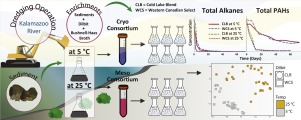Journal of Hazardous Materials ( IF 13.6 ) Pub Date : 2018-03-21 , DOI: 10.1016/j.jhazmat.2018.03.030 Ruta S Deshpande 1 , Devi Sundaravadivelu 1 , Stephen Techtmann 2 , Robyn N Conmy 3 , Jorge W Santo Domingo 3 , Pablo Campo 4

|
Treatability experiments were conducted to determine the biodegradation of diluted bitumen (dilbit) at 5 and 25 °C for 72 and 60 days, respectively. Microbial consortia obtained from the Kalamazoo River Enbridge Energy spill site were enriched on dilbit at both 5 (cryo) and 25 (meso) ºC. On every sampling day, triplicates were sacrificed and residual hydrocarbon concentrations (alkanes and polycyclic aromatic hydrocarbons) were determined by GC-MS/MS. The composition and relative abundance of different bacterial groups were identified by 16 S rRNA gene sequencing analysis. While some physicochemical differences were observed between the two dilbits, their biodegradation profiles were similar. The rates and extent of degradation were greater at 25 °C. Both consortia metabolized 99.9% of alkanes; however, the meso consortium was more effective at removing aromatics than the cryo consortium (97.5 vs 70%). Known hydrocarbon-degrading bacteria were present in both consortia (Pseudomonas, Rhodococcus, Hydrogenophaga, Parvibaculum, Arthrobacter, Acidovorax), although their relative abundances depended on the temperatures at which they were enriched. Regardless of the dilbit type, the microbial community structure significantly changed as a response to the diminishing hydrocarbon load. Our results demonstrate that dilbit can be effectively degraded by autochthonous microbial consortia from sites with recent exposure to dilbit contamination.
中文翻译:

淡水富集使冷湖混合气和加拿大西部的部分地域微生物降解。
进行了可处理性实验,以确定分别在5和25°C下分别稀释72天和60天的沥青的生物降解能力。从卡拉马祖河Enbridge能源泄漏场获得的微生物群落在5(低温)和25(中观)℃的Dilbit富集。在每个采样日,一式三份,并通过GC-MS / MS测定残留的烃浓度(烷烃和多环芳烃)。通过16 S rRNA基因测序分析鉴定了不同细菌组的组成和相对丰度。虽然在两个头皮之间观察到了一些理化差异,但它们的生物降解特性却相似。在25°C时降解速率和降解程度更高。两个财团都代谢了99.9%的烷烃。然而,中观联盟比冷冻联盟更有效地去除芳族化合物(97.5对70%)。两个财团中都存在已知的降解烃细菌(假单胞菌,红球菌属,Hydrogenophaga,Parvibaculum,节杆菌,食酸菌属),尽管它们的相对丰度取决于在它们被富集的温度。不管是哪种类型,微生物群落结构都会随着对碳氢化合物负荷的减少而发生显着变化。我们的研究结果表明,自体微生物财团可从最近暴露于迪尔比特污染的地方有效地降解迪尔比特。


























 京公网安备 11010802027423号
京公网安备 11010802027423号